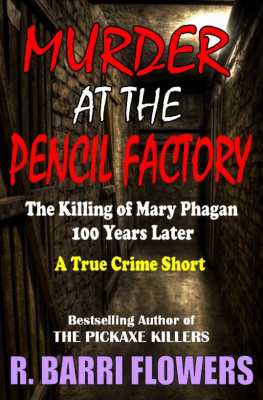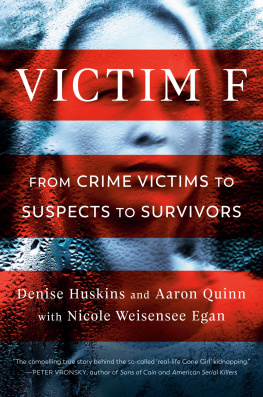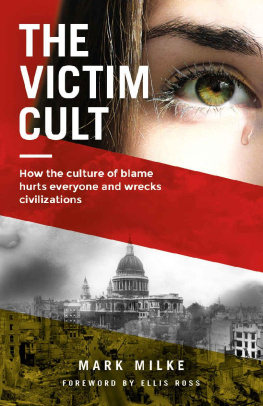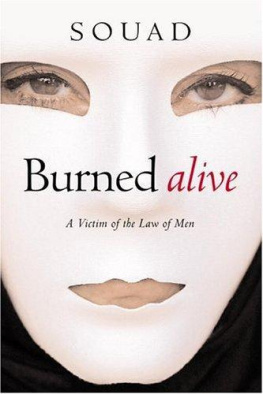Victim
Victim
THE OTHER SIDE OF MURDER
Gary Kinder

Copyright 1982 by Gary Kinder
All rights reserved. No part of this book may be reproduced in any form or by
any electronic or mechanical means, including information storage and
retrieval systems, without permission in writing from the publisher, except by
a reviewer, who may quote brief passages in a review. Any members of
educational institutions wishing to photocopy part or all of the work for
classroom use, or publishers who would like to obtain permission to include
the work in an anthology, should send their inquiries to Grove/Atlantic, Inc.,
841 Broadway, New York, NY 10003.
Originally published by Delacorte Press
Published simultaneously in Canada
Printed in the United States of America
FIRST ATLANTIC MONTHLY PRESS EDITION
Library of Congress Cataloging-in-Publication Data
Kinder, Gary.
Victim, the other side of murder / Gary Kinder,
p. cm.
Originally published: New York : Delacorte Press, 1982.
ebook ISBN-13 978-1-5558-4797-5
1. Naisbitt, Cortney, 1957 . 2. Andrews, William. 3. Pierre,
Dale, 1953 . 4. MurderUtah. 5. Murder victimsUtah.
I. Title.
HV6533.U8K56 1999
364.1523?979228dc21 98045612
Design by Mary Jane DiMassi
Atlantic Monthly Press
841 Broadway
New York, NY 10003
ACKNOWLEDGMENTS
The characters who appear by name in this book have been thanked before, but I would like to thank them again. The value of their time and consent to explore an event in their lives that was sometimes painful to recall cannot be measured. In addition I would like to thank the doctors, nurses, medical technicians, teachers, police officers, citizens of Trinidad and Tobago, and friends and neighbors of the Naisbitt family whose names do not appear in the book but whose contributions were essential to my understanding of the story. A special thanks to Assistant Chief of Police Dave Reed and nurse Bonnie Judkins.
I welcome this opportunity to thank personally and publicly my agents Arthur and Richard Pine for taking on a new writer with a first book and offering encouragement during the years when there was little to be encouraged about; my editor Morgan Entrekin whose enthusiasm, sensitivity, and integrity are what every writer dreams of finding in an editor; my friends Jim and Shera Arango, and their daughters, Melinda, Valerie, Lisa, and Samantha, who during my frequent research trips to Ogden provided me with the warmth of a home away from home; Becky Dittmer and Chris Jensen, not only for their typing of countless transcript and manuscript pages but for their spirit of cooperation; Becky Valasek, who read the original manuscript and offered insight for its improvement; Patrick Chooko-lingo, owner and publisher of Trinidad and Tobagos newspaper, The Bomb, for his patronage and for making available to me James Ramlogan, a thorough reporter and good companion whose street wisdom was invaluable to my work in the West Indies; Irving and Sylvia Wallace for their genuine interest in new writers and for introducing me to the Pines; Peter Schwed for holding my head above water while I learned more about swimming; Gil Athay and Robert Van Sciver for letting an outsider tag along; Earl Dorius and Craig Barlow of the Utah Attorney Generals office for their patient explanations and ready availability; Geoff Irvin of Blue Cross-Blue Shield who assisted me in compiling medical costs; Fred Montmorency, a private citizen who offered me his research on the cost of the Hi-Fi Murder trial; Tony Bair for his cooperation in arranging prison visitations; the Ernest Evans family for their faith and support; and Randy, my brother and friend, who has been as encouraging and hopeful as if the book were his own.
Last I would like to thank my wife, Alison, who has never known me when I was not working on this book, and who shared me with it for seven years. Without her love and understanding and sacrifice it would never have been completed. Now we can get on with our lives together.
This book is dedicated with love
To the two people whose influence
Long ago prepared me for writing it
My mother and my father
The story itself
Belongs to the Naisbitt family,
And I am indebted to each of them
For sharing their part of it with me
AUTHORS NOTE
Victim is a true story. No names or facts have been changed. All material not derived from my own experience is taken from police, hospital, and Air Force records; trial transcripts; correspondence; or extended interviews with those persons directly involved.
In some instances I have assumed the physical consequences of a particular action I know from interviews or records took place.
With the exception of the perpetrator Dale Pierre none of the characters appearing in this book was promised payment for his or her cooperation. Pierre has been provided with perhaps twenty-five books, plus pens, pencils, paper, and other educational materials in return for his agreement to answer questions and provide information on his past.
GARY KINDER
THE VICTIMS
St. Benedicts Hospital sat high on the east bench overlooking Og-den, Utah. It was an old three-story structure made of red brick, and from its rooftop shone a fluorescent white cross. At night the panorama spreading before it was a city of one hundred thousand, the lights streaking and twinkling in the distance all the way to the shores of the Great Salt Lake.
That Monday evening, April 22, 1974, was warm and darkness had settled over the city. The St. Benedicts emergency room was quiet. At 10:40 emergency physician Dr. Jess Wallace was in the hallway talking to Dr. James Allred, when a loud buzzer sounded. Wallace ran into the ER office and flicked on the emergency receiver, a hotline between the hospital and emergency ambulance units. The driver calling in was talking so fast Wallace could hardly understand him. Seconds later the driver had signed off and Wallace knew only that an ambulance was coming in with two people shot in the head. They would be at the hospital in three minutes.
Wallace said to Allred, Stick around, I may need you.
Then he flipped a switch, lighting a large red flasher on the switchboard upstairs. Immediately, ER alert reverberated over the hospital intercom. Far below, in the middle of town, the flashing red lights of the ambulance began whirling silently in the night.
The glass doors to the emergency room were propped open, and the two doctors were joined in the hallway by nurses from Intensive Care and Coronary Care, a medical technician, a respiratory technician, an X-ray technician, and the nursing supervisor. They waited by the open doors for an ambulance they were certain carried two bodies from Ogdens notorious Twenty-fifth Street. Winos from the street were rushed to the hospital regularly to have their heads sewn up or a knife wound closed or to be pronounced DO A from one cause or another. Someone standing by the door said that this time one of them had probably shot his old lady then turned the gun on himself. Each of the crew feared only that he or she would be assigned to peel off the shoes or the socks or the underwear of one of the victims.
As the crew waited by the ER doors, the ambulance zigzagged through the grid of city blocks, moving steadily toward the hospital. Traffic was light, and the few cars on the streets cleared away at the sound of the approaching sirens. The motorcycle escort passed first; then a hundred yards behind it came the ambulance at a steady fifty miles an hour. Eight blocks from town they swung right onto Harrison, sped up for a few blocks, then braked and swung left at the high school. Behind the motorcycle the ambulance driver shot straight up the hill, turned right, shut down the siren, and raced the last two blocks to the neon orange EMERGENCY.
Next page









